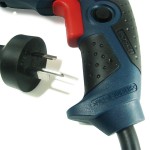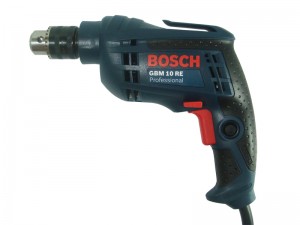
© Milwaukee
The Best Rotary Drills Australia, Information, Buyers Guides, Comparisons and Reviews
– Rotary Drill Features
– Rotary Drill Accessories
– What Rotary Drill To Buy
– Rotary Drill Operating Tips
Rotary drills are a perfect tool for light duty tasks around the house and workshop. They are designed for drilling small holes through wood, metal and plastics, and are commonly used for riveting and manufacturing. They can also be used as an electric screwdriver.
They usually weigh in at about the 1kg mark, which make them very easy to control and considerably reduce any fatigue you may otherwise be feeling.
For specialised tasks, rotary drills called right angle drills are available. The chuck of these drills is positioned at 90° to the body of the drill, which caters for situations where there is very little clearance.
Rotary Drill Features
Rotary drills feature many different components, and having a sound understanding of these plays an important part in the purchasing process. Knowledge of these parts also aids in the efficient and effective use of the tool.
 Power Source
Power Source
The power source is the component that provides the tool with electricity. On rotary drills, this is done through a wired connection to a mains power supply. In Australia, rotary drills operate off mains power (240V) through a 10A socket.
Switch
 The switch allows the electricity from the power source to flow through the tool. All portable drills are activated by a trigger switch. When this trigger is pressed, the drill will begin to operate.
The switch allows the electricity from the power source to flow through the tool. All portable drills are activated by a trigger switch. When this trigger is pressed, the drill will begin to operate.
The most common type is the variable speed trigger. The further you depress this trigger, the faster the drill will rotate.
All rotary drills should come with a variable speed trigger. This allows for greater control over the tool, and makes it very easy for use as a light-duty electric screwdriver.
 Lock-On Button
Lock-On Button
This button can be pushed while the trigger is depressed and the trigger will lock on to that set speed. To cease this function, simply pull the trigger.
Make sure this button has been released prior to disconnecting the tool. If not, the tool will begin to operate upon reconnection and may result in injury. For more safety recommendations, click here.
 Forward/Reverse Switch
Forward/Reverse Switch
With a flick of this switch, the drilling direction changes to allow for forward and reverse motion (right and left motion respectively). This feature is found on most drills, and can be very helpful if you need to remove screws, or if you need to release your drill bit after it has jammed in a hole.
If flicked between forward and reverse in a neutral position, it also locks the switch to prevent accidental operation of the tool.
Some of the smaller models of these drills do not come with a forward and reverse switch, and if you do require that reversing capability, you should make sure you take this into account.
You should never change the direction of drive whilst the tool is still operating, as it is highly likely you will damage the tool’s gears.
Rotary Drill Motors
Motors are the main component of all power tools, and are the component that converts the electricity into motion. The power that motors produce is measured in Watts (W). Motors used in portable electric drills are called AC motors (they are also known as universal or series motors).
Generally, rotary drills will not have very large motors. This is because they are only meant for smaller jobs. The input power of their motors range from 250W to 500W.
Many manufacturers will state only the input power of the drill, as this is the larger and more impressive number. This value is actually just an indication of the demand a tool will place on a power outlet under normal operating conditions. The power output at the chuck, though, is significantly less than the input power. This is due to the efficiency of the drill’s internal components, and how power is transferred through the machine. Generally speaking, higher quality tools have greater efficiency and require less input power to produce the same power output. Therefore, although it is uncommon for most manufacturers to include a power output value, it is a much better way of comparing tools.
Transmission
Also known as a gearbox, transmissions dictate the speed range (revolutions per minute, or rpm) that a drill can operate at, and the corresponding torque (or turning force) that it can produce.
Transmissions can contain single or multiple gears that are driven by the motor. If a small gear is used in the transmission, then rotary speed will be high but torque will be quite low. If a large gear is used, then rotary speed will be quite low, but torque will be high.
Electric drill accessories come in many different sizes, and all have a recommended speed that they have been designed to operate at. To accommodate these requirements, you must have a drill that has both enough torque and enough speed to handle the accessory.
To acknowledge this fact, manufacturers will state the maximum drilling capacities that a drill is capable of drilling into various materials.
Rotary drills only have a single gear transmission, and are geared for high speed. They generally have maximum speeds that range from 2000rpm to 4500rpm.
These fast speeds are ideal for smaller diameter drill bits, which should form the bulk of a rotary drill’s workload. In metal, maximum drilling sizes range from 6mm-10mm, and in wood, from 10mm-25mm.
The optimum drilling capacities of drills are where they will deliver their best performance. If you halve the drill’s maximum drilling capacity, it will give you the optimum drilling size, and is the size of hole you should be most frequently drilling with that drill. These maximum drilling sizes depend on the specific model of the drill, and it is recommended that you consult these specifics before making a purchase.
 Rotary Drill Chucks
Rotary Drill Chucks
The chuck is the part of the drill that grips drilling accessories. The transmission powers the drive shaft and on the end of this shaft is the chuck. On rotary drills, there are two types of chucks – keyed and keyless.
Keyed chucks have a solid metal construction – which makes them very durable through excessive vibrations and dust – and are operated by a chuck key. When fitted to the chuck, the chuck key fits into the gear notches of the chuck. As you turn it, it either loosens or tightens the chuck (depending on the turning direction).
It is a good idea to use the chuck key on all three notches of the chuck to ensure each jaw is securely tightened.
Keyless chucks are much faster to use, and can be operated completely by hand. Depending on the quality and purpose of the drill, these chucks can be plastic or metal, or a combination of the two, and usually have a front and rear sleeve. To loosen/tighten the chuck manually, place one hand on the rear sleeve of the chuck and turn the front sleeve right/left. To do this with the aid of the drill, hold the front sleeve of the chuck while you apply some reverse/forward acceleration to the drill.
Some higher quality keyless chucks will also have a locking and/or ratcheting feature when you tighten them so the chuck will never come loose during operation.
As these drills are only designed to drill small holes, there is no need for a large 13mm (1/2”) capacity chuck. Most standard drills come with a 10mm (3/8”) keyed or keyless chuck. Generally speaking, most chucks on drills of this size should have the capacity to hold down to a 1mm drill bit.
 Handle
Handle
The handle is the component of the drill that you hold with your dominant hand and is what you use to apply pressure to the drill.
On rotary drills, the handle is called a pistol-grip handle. Some models will have a finger mould toward the top of the handle for your thumb and index finger. This feature allows you to apply forward pressure in a more efficient manner, by pushing in line with the drive shaft and chuck. The pistol grip handle is commonly partially covered by rubber for user-comfort too.
 Housing
Housing
The housing of a drill is the casing that protects the internal components.
Rotary drills will typically have a clamshell housing. This is where the housing is manufactured in two plastic halves, and where these halves are fixed together around the internal components.
Rotary Drill Accessories
For a comprehensive guide to the accessories that can be used in rotary drills, please see our separate drilling accessories section.
What Rotary Drill To Buy
The main considerations you should make include how much power you require, the size and weight of the tool, whether you need it to be cordless, and how often you will be using it. When purchasing a rotary drill, decide what features are most important to you (from the specifications above) and make sure these are included in your final purchase.
A rotary drill should be lightweight, and simple and comfortable to use.
Manufacturers will either direct their products at the DIY or professional market. DIY tools are designed for home use and generally include plenty of features for a very modest price. They also tend to have very generous warranty periods, including replacement warranties. Professional tools are designed for commercial use and are built for durability, performance, and reliability. Their warranty periods tend to be much shorter than DIY tools, and are exclusively repair warranties. The main advantage of these tools is that they should well outlive their warranty period, and if they require repair and maintenance spare parts are readily available.
The price of any tool will depend on the quality, capabilities, and features of the model. Bear in mind that at least one of these three elements is commonly sacrificed by manufacturers to reduce the tool’s price and increase its sales. After all, price is the most important factor for consumers.
Rotary drills can cost anywhere from $30 to $250.
Right angle rotary drills are typically more expensive, ranging in price from $250 to $550.
It is important to bear in mind that the entire cost of any power tool is not just it’s initial purchase cost. Added costs can include accessories for the tool to function, maintenance, downtime, and replacement costs. Buying according to your requirements will help to keep these costs to a minimum.
To browse manufacturers of rotary drills, please select a company from our list of power tool manufacturers.
Rotary Drill Operating Tips
The following tips will help to preserve the life of your rotary drill, increase your efficiency, and most importantly, keep you safe.
- If the bit jams because the power tool is overloaded or it becomes wedged in your work, switch the power tool off immediately. Because of this, you should always prepare yourself for a sudden reaction force when drilling.
- Hold the drill firmly to counter any light reaction forces when drilling or driving screws.
- Always wait until the machine has come to a complete stop before placing it down.
Personal protective equipment (PPE) must always be worn when operating power tools. For more information on PPE and power tool safety, click here.
Was this guide helpful? Has anything been left out? Are there any improvements that could be made? Please take a moment of your time and click here to provide your valuable feedback.






